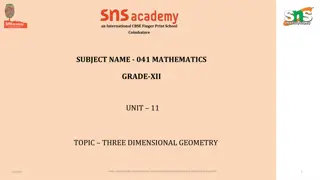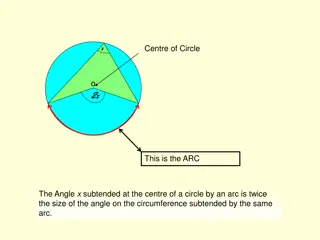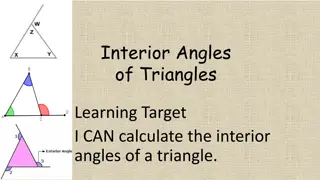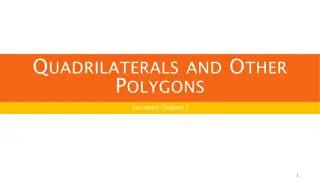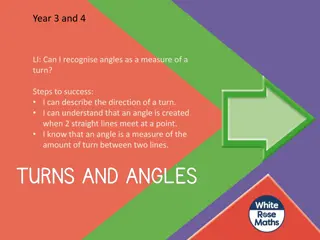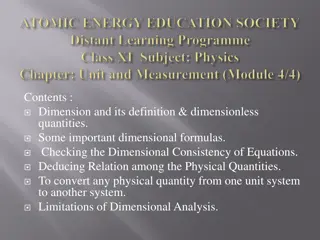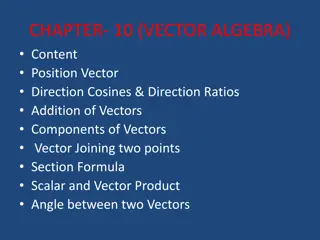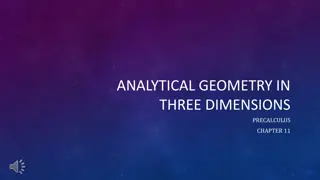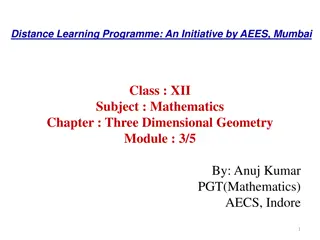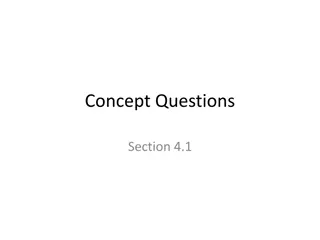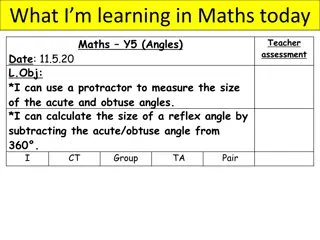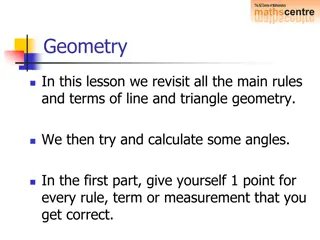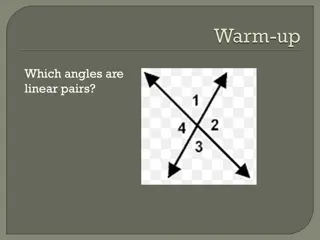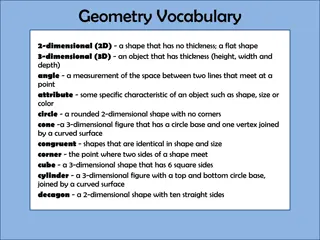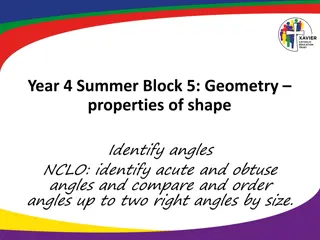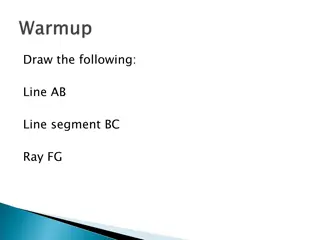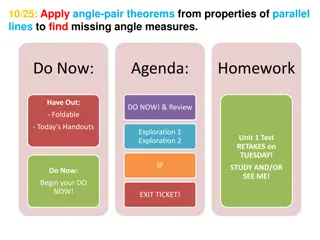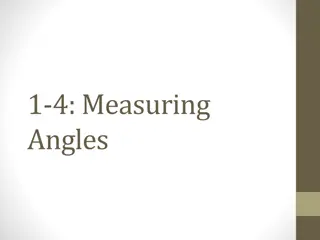Three-Dimensional Geometry: Direction Cosines and Angles
Understanding direction cosines and angles in three-dimensional geometry is crucial for determining the orientation of lines in space. By calculating direction cosines, we can find the angles a line makes with the positive directions of the X, Y, and Z axes. This knowledge helps in various geometric calculations, such as finding the shortest distance between skew lines, determining coplanarity of lines, and showing collinearity of points. The process involves using trigonometric functions and directional ratios to establish relationships between lines and points in space.
Download Presentation

Please find below an Image/Link to download the presentation.
The content on the website is provided AS IS for your information and personal use only. It may not be sold, licensed, or shared on other websites without obtaining consent from the author. Download presentation by click this link. If you encounter any issues during the download, it is possible that the publisher has removed the file from their server.
E N D
Presentation Transcript
CH 12 THREE DIMENSIONAL GEOMETRY CONTENT: Straight Line in space and Equation Angle Between Two lines Shortest Distance between skew Lines Co-planarity of Two Lines
Direction Cosines and Direction Ratios i) Direction Angles: As we have studied in two dimensional geometry each line is having slope in terms of tangent of the angle made by the line with positive direction of X axis. Similarly in three dimensional geometry if a directed line is passing through origin makes angles , and with positive directions of X, Y and Z axes respectively then the angles are known as direction (angels are shown in adjacent figure) angles. 2
ii) The cosine of these directed angles, cos, cos, and cos are termed as direction cosines of the line with general notation l, m and n respectively. These can be obtained using above figure as follows- x l y z = = = = = = cos , cos , cos m n + + + + + + 2 2 2 2 2 2 2 2 2 x y z x y z x y z and a relation can also be obtained as 2 2 2 x y z + + = + + 2 2 2 l m n + + + + + + 2 2 2 2 2 2 2 2 2 x y z x y z x y z + + 2 2 2 x y z = = 1 + + 2 2 2 x y z + + = 2 2 2 1 l m n Note-1: If the direction of the line is reversed then direction angles will be replaced by - , - and - i.e. the signs of direction cosines are reversed. 3
Note-4: The drs of a line segment with end points at P(x1, y1, z1) and Q(x2, y2, z2) are x2 x1, y2 y1, z2 z1 or x1 x2, y1 y2, z1 z2 after getting dr sof line segment as a, b, c we can find dc s l, m, n. Example-1: If a line make 90o,135 o,45 o with the x, y ,and z axes respectively find it direction cosines. Solution: The dc s can be obtained as l = cos90 =0, m = cos135 = , n = cos45 = Example-2: If dr s of a line are 6, 2, 3 then find its dc s. Solution: a = 6, b = 2, c = 3 then , 3 2 6 + + + 1 1 2 2 6 2 3 = = = , l m n + + + 2 2 2 2 2 2 2 2 2 6 2 3 6 2 3 6 2 3 = = = , , l m n 7 7 7 4
Example-3: Find the direction cosines of the line joining of the points (7, - 5, 9) & (5, -3, 8). Solution: The dr s of line joining of A(7, -5, 9) & B(5, -3, 8) are 5 7, 3 + 5, 8 9 i.e. 2, 2, 1 Now dc s of line joining of A & B can be obtained as = = = n m l 2 2 1 2 2 1 = = = , , , , or l m n 3 3 3 3 3 3 Example-4: Show that the points (1, 2, 3), (2, 3, 4), (0, 7, 10) are collinear. Solution: The similar problem had been solved by us in class XI using section formula as well as in Vector Algebra. Now we will see how to show using dr s& dc s. The points A (1, 2, 3), B(2, 3, 4), C(0, 7, 10) will be collinear if dr s of AB will be proportional to the dr s of BC. dr s of AB 1, 5, 7 and dr s of BC 2, 10, 14 Since 14 10 2 1 5 7 = = therefore A, B & C are collinear. 5
Equation of line in space 1. Equation of a line passes through a point and parallel to given vector: Let l be a line passes through A whose position vector is ?? and it is parallel to a vector ? . If P is a general point on the line whose position vector is ?? then ?? = ? ?? ? ? = ? or ? = ? + ? is the required equation of the line and known as vector form of straight line. = ? = ? = ? ?? 6
If ? = ?? + ?? + ?? ,? = ?1? + ?1? + ?1? and ? = ?? + ?? + ?? then the cartesian form the line will be as ? ?1 ? = ? = Example-5: Find the equation of line passes through (5, - 2, 4) and parallel to the vector 2? ? + ? . Solution: Vector form:? = ? + ? ? =5? 2? + 4? + 2? ? + ? Cartesian form:? ?1 ? = ? 5 2 = Note-5: In above example we can observe the conversion of vector form to Cartesian or vice versa. ? ?1 ? ?1 ?. ? ?1 ? ? 4 1 ? ?1 ? = ?+2 1= 7
Note- 2: If the line is not passing through origin then a line passes through origin can be drawn which is parallel to the given line then the direction cosines of both the lines will be proportional. Note- 3: Three numbers which are proportional to the direction cosines of a line are said to be direction ratios of the line. If l, m and n are dc s of a line then its dr s will be as a = l, b = m and c = n where R-{0}. 1 l let k c b a = + + l m n = = = = = = = ( ) , , ak m bk n ck + + = 2 2 2 2 2 2 2 2 2 1 1 We know that l m n a k b k c k 1 b + + = = 2 2 2 2 ( ) 1 k a b c k + + 2 2 2 a c a b c = = = , , l m n + + + + + + 2 2 2 2 2 2 2 2 2 a b c a b c a b c ' . these are dc s of the line 8
2. Equation of a line passes Through two given points: Let l be a line passes through A and B whose position vectors are = ? ????? = ? . If P is a general point on the line whose position vector is ?? then ?? = ?? ?? ?? = (?? ? ? = (? ? ) the required equation of the line and known as vector form of straight line. ?? = ? ?? ), 9
If ?? = ? = ?1? + ?1? + ?1? and ?? = ? = ?2? + ?2? + ?2? then catesian form of the line will be as ? ?? ?? ??= Example-6: Find the equation of line passes through A(3, 4, -7) & B(5, 1, 6). Solution: A(3, 4, -7) ? =3? + 4? 7? B(5, 1, 6) ? =5? + ? + 6? Vector form:? ? = ? ? ? 3? + 4? 7? =5? + ? + 6? 3? + 4? 7? ? 3? + 4? 7? =2? 3? + 13? Cartesian form:? ?? ?? ??= ? 3 ? ?? ?? ??= ? ?? ?? ?? ? ?? ?? ??= ? ?? ?? ?? 5 3=? 4 ? 3 2 1 4=?+7 =? 4 6+7 3=?+7 13 10
IMPORTANT NOTE Shortest distance b/w two skew lines Lines are not co-planer Distance between parallel lines
Planes Although a line in space is determined by a point and a direction, a plane in space is more difficult to describe. A single vector parallel to a plane is not enough to convey the direction of the plane, but a vector perpendicular to the plane does completely specify its direction. Thus a plane in space is determined by a point P0(x0, y0, z0) in the plane and a vector n that is orthogonal to the plane. This orthogonal vector n is called a normal vector.



